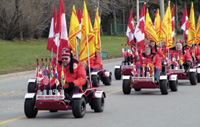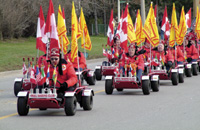Fuji FinePix S7000; Recording Options And A New CCD Sensor
The first digital camera to incorporate Fujifilm's Super CCD HR (High Resolution) the FinePix S7000 is a full-featured 6.3-megapixel model that can generate 4048x3040 recorded pixels through in camera interpolation. More sophisticated than the earlier Super CCD III, the HR sensor is said to produce wide dynamic range, very high resolution and sensitivity, great color fidelity, and high signal-to-noise ratio. That combination was intended to produce excellent picture quality, a prerequisite for any image that will be doubled in size through in camera interpolation. |
|||||
But how successful is SuperCCD HR technology in real world photography? Is the Fuji interpolation process more effective than bicubic interpolation in Photoshop in terms of image quality? And what are the tradeoffs for the additional in camera processing that's required? These were the primary issues that I considered while testing the FinePix S7000 and you'll find a full evaluation of each in this review. Primary Capabilities |
|||||
JPEG Recording Modes
|
|||||
Evaluation: In its native (6-Mp) capture mode, the S7000 produces JPEGs with moderate color saturation with rich reds, very good fidelity to the subject, pleasing skin tones, accurate white balance, and fairly high resolution of fine detail. Contrast is moderate, allowing for a good (though not exceptional) level of detail in highlight and shadow areas. Because of the aggressive compression, my JPEGs exhibit some artifacts, primarily digital noise most noticeable in ISO 400 and 800 images. But there's little evidence of jagged edges even after application of USM in Photoshop. Before making prints from my best 6-Mp ISO 200 images, I also boosted color saturation and contrast; the 8.5x11" outputs are impressive in all respects: crisp, clear, sharp, and colorful. 12-Mp Mode Raw Capture Options
|
|||||
Final Evaluation Peter K. Burian, a freelance stock photographer, and long-time eDigitalPhoto and Shutterbug contributor, is the author of a new book, Mastering Digital Photography and Imaging (Sybex, Feb. 2004). Covering all aspects of the topic--the technology, equipment and techniques--this book provides 300 pages of practical advice for photo enthusiasts. PROS CONS Facts Contact |
- Log in or register to post comments










































